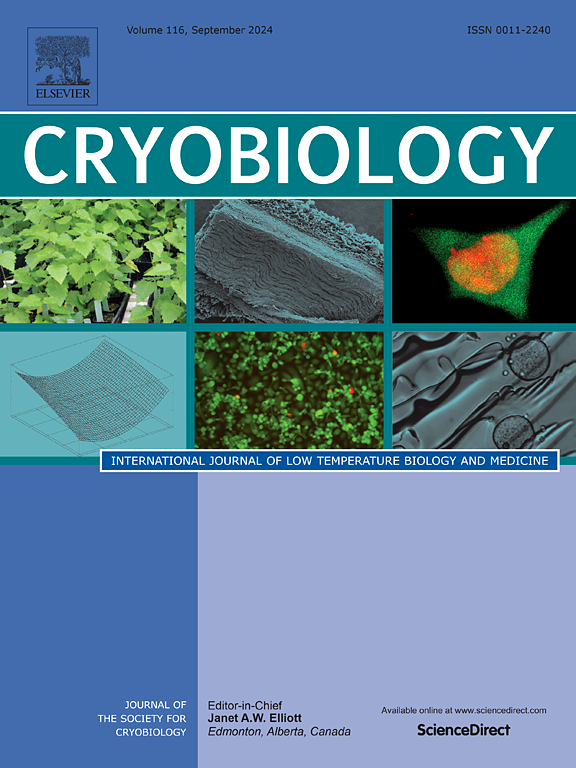在球体中超高速冷冻产生比在吸管中更高的抗冻性,但仍然不如传统的慢速冷冻的种马精子
IF 2.1
3区 生物学
Q2 BIOLOGY
引用次数: 0
摘要
本研究分别用微球和吸管超快速(UR)冷冻法和常规慢速(CS)冷冻法对种马精子的抗冻性进行了研究。将4匹公马的16支射精按冷冻方法分成3份:用液氮(LN2)直接浸泡在30 μ l的小球(UR- spheres)中进行UR冷冻;将UR冷冻于0.25 ml吸管(UR- straw)中,在LN2中直接水平浸没;和CS在LN2蒸气中冻结。超高速冷冻培养基为100 mM海藻糖+ 1%牛血清白蛋白,CS冷冻培养基为5%二甲基甲酰胺。常规慢速冷冻的精子抗冻性高于两种冷冻方法(P < 0.05)。UR-Spheres比ur - straw产生更高的精子运动、活力和顶体完整性值(P < 0.05)。两组精子头部面积和周长均比新鲜和CS冷冻样品增加(P < 0.05)。综上所述,用UR-Spheres法测定种马精液的抗冻性优于UR-Straw法。本文章由计算机程序翻译,如有差异,请以英文原文为准。
Ultra-rapid freezing in spheres yields a higher cryoresistance than in straws but remains inferior to conventional slow freezing of stallion sperm
This study evaluated the cryoresistance of stallion sperm frozen by ultra-rapid (UR) methods using microspheres and straws or by the conventionally-slow (CS) method. Sixteen ejaculates from four stallions were each divided into three aliquots according to the freezing method: UR freezing in 30-μL spheres (UR-Spheres) by direct immersion in liquid nitrogen (LN2); UR freezing in 0.25-mL straws (UR-Straws) by direct horizontal submersion in LN2; and CS freezing in LN2 vapors. Ultra-rapid freezing medium included 100 mM trehalose +1 % BSA, and the CS freezing medium contained 5 % dimethylformamide. Conventional-slow freezing yielded higher sperm cryoresistance than both UR freezing methods (P < 0.05). UR-Spheres produced higher values of sperm kinematic, viability, and acrosomal integrity than UR-Straws (P < 0.05). Sperm head area and perimeter in both UR freezing groups increased compared to fresh and CS frozen samples (P < 0.05). In conclusion, the UR-Spheres method produced greater cryoresistance of stallion semen than UR-Straw method.
求助全文
通过发布文献求助,成功后即可免费获取论文全文。
去求助
来源期刊

Cryobiology
生物-生理学
CiteScore
5.40
自引率
7.40%
发文量
71
审稿时长
56 days
期刊介绍:
Cryobiology: International Journal of Low Temperature Biology and Medicine publishes research articles on all aspects of low temperature biology and medicine.
Research Areas include:
• Cryoprotective additives and their pharmacological actions
• Cryosurgery
• Freeze-drying
• Freezing
• Frost hardiness in plants
• Hibernation
• Hypothermia
• Medical applications of reduced temperature
• Perfusion of organs
• All pertinent methodologies
Cryobiology is the official journal of the Society for Cryobiology.
 求助内容:
求助内容: 应助结果提醒方式:
应助结果提醒方式:


